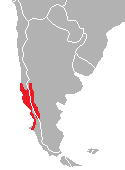Southern pudu
| Southern pudu | |
|---|---|

| |
| Southern pudu (P. puda) | |
| Scientific classification | |
| Kingdom: | Animalia |
| Phylum: | Chordata |
| Class: | Mammalia |
| Order: | Artiodactyla |
| Family: | Cervidae |
| Subfamily: | Capreolinae |
| Genus: | Pudu |
| Species: | P. puda
|
| Binomial name | |
| Pudu puda (Molina, 1782)
| |

| |
| Geographic range of Pudu puda | |
| Synonyms | |
|
Capra puda Molina, 1782[3] | |
The southern pudu (Pudu puda, Mapudungun püdü or püdu,[4] Spanish: pudú, Spanish pronunciation: [puˈðu]) is a species of South American deer native to the Andes of Chile and Argentina. It is found in high-altitude forests and is classified as Near Threatened in the IUCN Red List.
Description[]
The southern pudu is characterized by being the second smallest deer in the world. It is slightly larger than its sister species, the northern pudu, being 35 to 45 cm (14 to 18 in) tall at the shoulder and weighs 6.4 to 13.4 kg (14 to 30 lb). The antlers of the southern pudu grow to be 5.3 to 9 cm (2.1 to 3.5 in) long and tend to curve back, somewhat like a mountain goat. Its coat is a dark chestnut-brown, and tends to tuft in the front, covering the antlers.[5] It is found at lower elevations than its sister species, from sea level to 2,000 m (6,600 ft).
Further reading[]
- Colihueque, Nelson; Arriagada, Aldo; Fuentes, Andrea (2020). "Distribution modelling of the Pudu deer (Pudu puda) in southern Chile". Nature Conservation. 41: 47–69. doi:10.3897/natureconservation.41.53748.
- Molina, J. Ignatius (1809). The Geographical, Natural, and Civil History of Chili. Longman. p. 256.
References[]
- ^ Silva-Rodríguez, E.; Pastore, H.; Jiménez, J. (2016). "Pudu puda". IUCN Red List of Threatened Species. 2016: e.T18848A22164089. doi:10.2305/IUCN.UK.2016-1.RLTS.T18848A22164089.en. Retrieved 12 November 2021.
- ^ "Appendices | CITES". cites.org. Retrieved 2022-01-14.
- ^ Molina, Giovanni Ignazio (1782). "Il Pudu, Capra Puda". Saggio sulla storia naturale del Chili. Bologna: S. Tommaso d'Aquino. pp. 308–309.
- ^ Muñoz Urrutia, Rafael, ed. (2006). Diccionario Mapuche: Mapudungun/Español, Español/Mapudungun (in Spanish) (2nd ed.). Santiago, Chile: Editorial Centro Gráfico Ltda. p. 184. ISBN 956-8287-99-X.
- ^ "Forest South America". Animal Welfare Institute. Archived from the original on 2009-02-18. Retrieved 20 September 2009.
- IUCN Red List near threatened species
- Deer
- Mammals of Chile
- Mammals of Argentina
- Taxa named by Juan Ignacio Molina
- Mammals described in 1782
